Anatomy 2 - Blood Vessels, Blood Pressure and the Lymphatic System
1/78
There's no tags or description
Looks like no tags are added yet.
Name | Mastery | Learn | Test | Matching | Spaced |
|---|
No study sessions yet.
79 Terms
What are the 3 principal categories of blood vessels?
Arteries - carry oxygenated blood away from the heart; veins - carry deoxygenated blood back to the heart; capillaries - connect arteries to veins to create a circuit
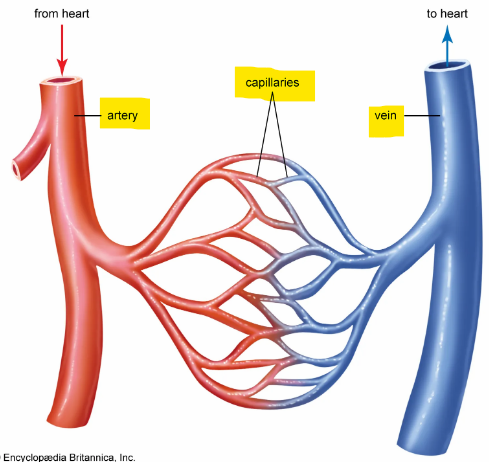
This is the simplest and most common route for blood
Heart > arteries > arterioles > capillaries > venules > veins
True or false; during one cycle, blood passes through only one network of capillaries
True
Walls of arteries and veins have 3 layers, what are they?
Tunica interna/intima (deep), tunica media (middle) and tunica externa (superficial)

This layer of the blood vessel wall is simple squamous epithelium and faces the lumen
Tunica interna/intima

What do endothelial cells produce when tissue around vessels are inflamed?
Cell-adhesion molecules
This layer of the blood vessel wall consists of smooth muscle and collagen
Tunica media
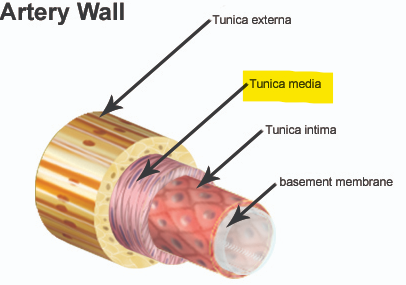
This layer of the blood vessel supports endothelium from rupturing and is for contraction
Tunica media
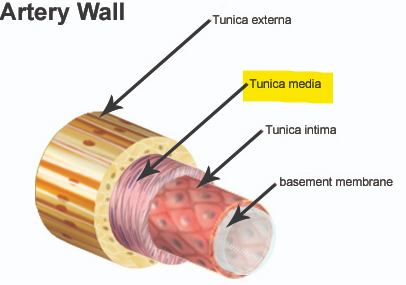
This layer of the blood vessel wall consists of smooth connective tissue
Tunica externa
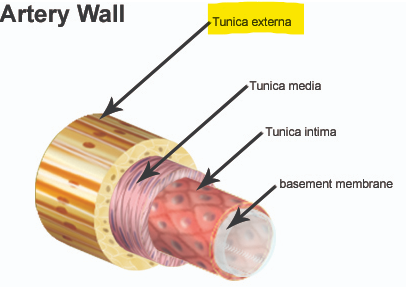
What is vasa vasorum?
Small vessels that supply blood to outer part of the larger vessels
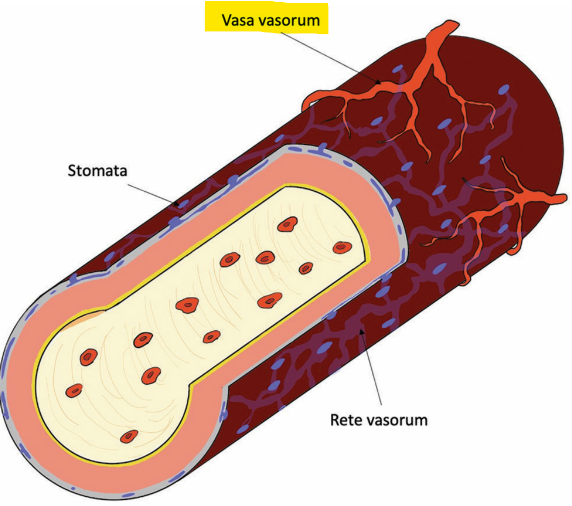
Describe the layering of a medium artery from most deep to most superficial
Endothelium, internal elastic lamina, tunica media, external elastic lamina and tunica externa
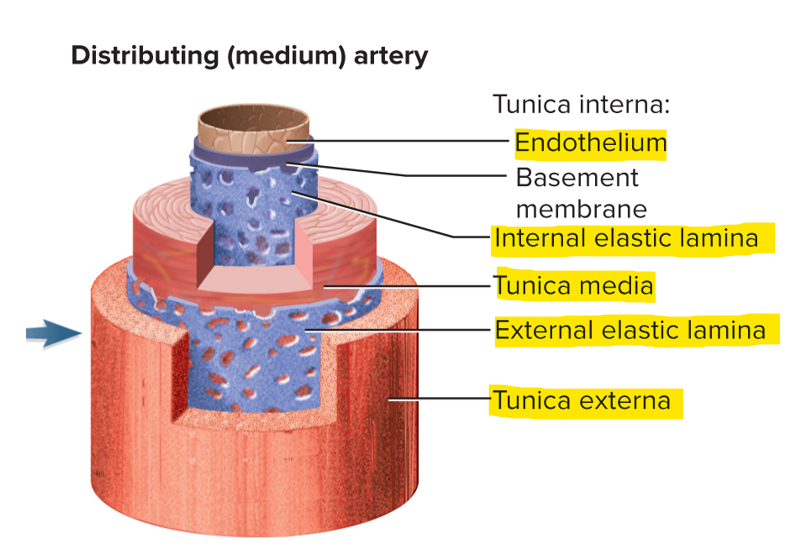
Describe the layering of a medium vein from most deep to most superficial
Tunica interna, tunica media and tunica externa
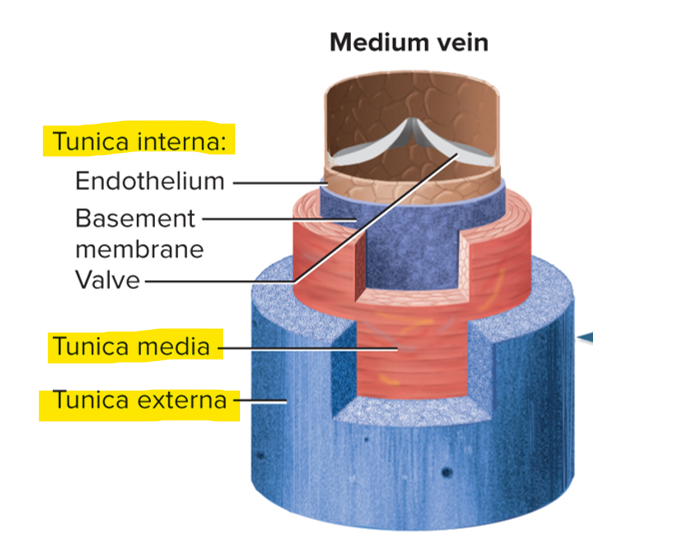
These are the biggest arteries; what are some examples?
Conducting (elastic or large) arteries. Examples: aorta, pulmonary trunk - blood from heart to lungs, common carotid - blood to the brain, subclavian - blood to upper limbs and common iliac arteries - blood to lower limbs
This artery delivers blood to specific arteries; what are some examples?
Distributing (muscular or medium) arteries. Examples: brachial - arm, femoral - legs, renal - kidneys and splenic arteries - spleen
These are the smallest of resistance arteries; what is their function?
Resistance (small) arteries - Arterioles. Function: Control the amount of blood to various organs; lumen is modulated with vasoconstriction and vasodilation
Which tunic is well developed in resistance arteries?
Tunica media
These are exchange vessels
Capillaries; where gasses, nutrients, wastes and hormones pass between the blood and tissue fluid
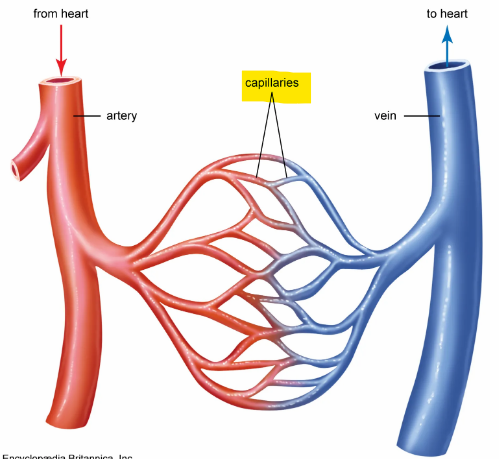
What are capillaries composed of?
Endothelium and basal lamina
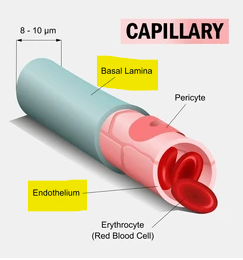
What are the 3 capillary types from least permeable to most permeable?
Continuous, fenestrated and sinusoids
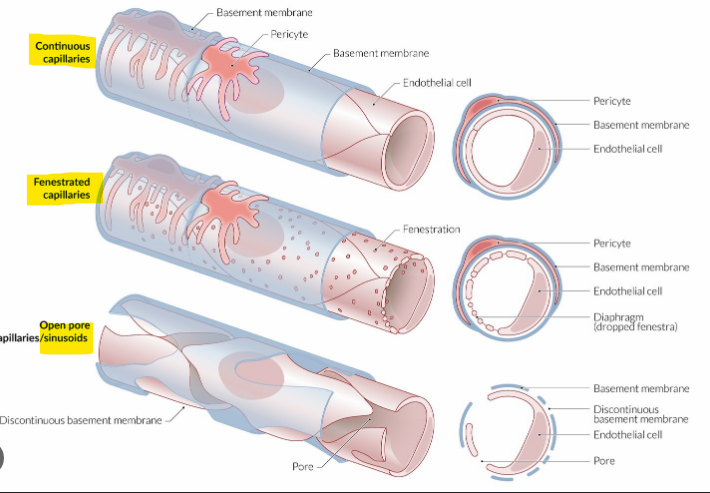
This is the least permeable type of capillary; what is it’s function?
Continuous capillary - very common, occurs in most tissues; it allows passage of solutes such as glucose
Where can you find fenestrated capillaries?
In organs that require rapid absorption or filtrations — such as the kidneys and small intestine; cells have filtration pores — fenestrations
This is the most permeable type of capillary; where are they found and what are there functions?
Sinusoids; found in the liver, bone marrow and spleen; they allow proteins and new blood cells to enter circulation
These have a greater capacity for blood containment than arteries
Veins; have a steady blood flow and low blood pressure
What are the 3 types of veins?
Postcapillary venules (smallest veins) - leukocytes leave the bloodstream though venule walls; medium veins - skeletal muscle pump propels venous blood back to the heart; large veins like vena cavae, pulmonary veins, internal jugular veins and renal veins

What is blood pressue?
The force that blood exerts against a vessel wall
Where is blood pressure measured?
Brachial artery
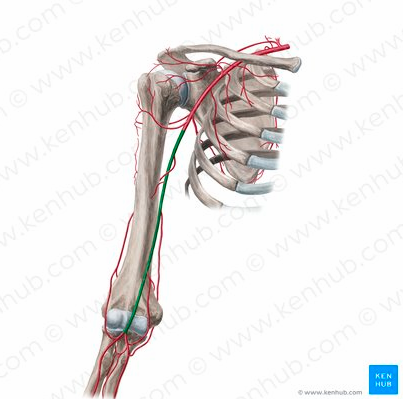
These are the two pressures recorded when taking blood pressue
Systolic (ventricular contraction) and diastolic (ventricular relaxation) pressure
What is the normal blood pressure for a young adult?
120/75 mm Hg - systole/diastole
This is the difference between systolic and diastolic pressue
Pulse pressure (systolic pressure - diastolic pressure)
BP is determined by these 3 variables
Cardiac output - how much blood is ejected into the arteries; blood volume - salt; resistance to flow - vasodilation and vasoconstriction
Besides the beating of the heart, this organ has the largest influence on blood pressure of any organ
The kidneys - excretes salt thus excreting volume
How does salt influence blood pressure?
Less salt = less volume so BP goes down; high salt = high volume so BP goes up
This is the opposition to flow that blood encounters in vessels away from the heart
Peripheral resistance
Resistance is determined by these 3 variables
Blood viscosity - albumin and RBCs raise viscosity the most; vessel length - longer = higher BP, shorter = lower BP; vessel radius - large lumen/hot = lower resistance, small lumen/cold = higher resistance
Albumin is produced by the _____
Liver
This is the most powerful influence on blood flow
Vessel radius; only significant way of controlling resistance
Define whether low and high viscosity speeds or slows the flow of blood
Low viscosity speeds the flow of blood; high viscosity slows the flow of blood
This is the rhythmic contraction and relaxation of vascular smooth muscle of arterioles
Vasomotion
What are the 3 ways of controlling vasomotor activity?
Local control, neural control and hormonal control
This is the ability of tissue to regulate their own blood supply
Autoregulation
Define the metabolic theory of autoregulation
If tissue is inadequately perfused, wastes accumulate, stimulating vasodilation which increases perfusion
These are substances secreted by platelets, endothelial cells and perivascular tissue to stimulate vasomotor responses
Vasoactive chemicals - vasomotor responses
What is shear stress? What does this stimulate?
The drag of blood flowing against the endothelial cells; stimulates endothelial cells to secrete vasodilators like nitric oxide
What is the vasomotor center and what does it do?
Medulla oblongata; it exerts sympathetic control over blood vessels throughout the body
These are the 3 autonomic reflexes of the vasomotor center
Baroreflexes, chemoreflexes and medullary ischemic reflex
This autonomic reflex responds to changes in blood pressure; what is able to detect this change?
Baroreflex; carotid sinuses detect increases in BP
What does an increase in BP lead to?
Inhibition of sympathetic cardiac and vasomotor neurons - leads to vasodilation and lower cardiac output; activation of the parasympathetic NS - slow heart rate and thus reduces BP
What does a decrease in BP lead to?
Activation of sympathetic cardiac and vasomotor neurons - leads to vasoconstriction and higher cardiac output; inhibition of the parasympathetic NS - increases heart rate and thus raises BP
This autonomic reflex responds to changes in blood chemistry
Chemoreflex
What are the 2 chemoreceptors?
Aortic bodies located in the aortic arch and carotid bodies located in the carotid arteries
What is the primary role of chemoreflexes?
To adjust respiration to changes in blood chemistry; stimulate breathing to eliminate CO2 and get more O2
What does hypoxemia (low O2), hypercapnia (high CO2) and acidosis stimulate? What does this increase?
Chemoreceptors to cause widespread vasoconstriction; increases BP and lung perfusion, leading to an increase gas exchange
This is the automatic response to a drop in perfusion of the brain
Medullary ischemic reflex; the medulla oblongata monitors its own blood supply
What is ischemia and what does it trigger?
Insufficient perfusion; triggers the medullary ischemic reflexes; increases heart rate and contraction force, causes widespread vasoconstriction and increases BP so that more oxygen will go to the brain
True or false; hormones also influence BP
True
This hormone raises BP and is a potent vasoconstrictor
Angiotensin II
This enzyme is required for the synthesis of Angiotensin II
Angiotensin-converting enzyme (ACE)
This hormone promotes Na+ retention by the kidneys and supports BP
Aldosterone
This hormone is secreted by the heart and lowers BP; how does it lower BP?
Natriuretic peptides; these peptides lower BP by inhibiting aldosterone which promotes vasodilation
This gland produces the antidiuretic hormone (prevents urination); what does this promote?
The posterior pituitary gland; promotes water retention and raises BP, it also acts as a vasoconstrictor
These are adrenal and sympathetic catecholamines
Epinephrine and norepinephrine; these cause vasoconstriction which raises BP
What are the two purposes of vasomotion (vasodilation and vasoconstriction)?
General control of BP; routing blood from one body region to another
What are the general functions of the lymphatic system?
Fluid recovery - fluids leaked from capillaries, 85% are reabsorbed; immunity - excess filtered fluid picks up foreign cells and chemicals from the tissues; lipid absorption - lacteals in small intestine absorb dietary lipids that are not absorbed by the capillaries
This is the recovered fluids of the lymphatic system
Lymph
These transport the lymph
Lymphatic vessels
What are lymphatic tissues composed of?
Aggregates of lymphocytes and macrophages
Describe lymphatic capillaries (terminal lymphatics)
Capillaries that are closed at one end, the endothelial cells overlap each other like roof shingles, this creates valve-like flaps that open when ECF pressure is high and close when its low
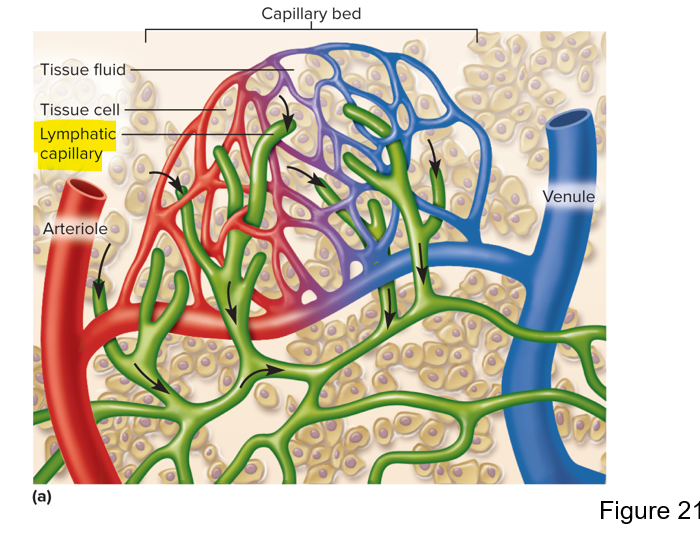
Where does lymph become blood?
In the lymphatic capillaries (terminal lymphatics)
These are an integral part of the lymphatic system; lymph passes through these to be filtered
Lymph nodes
What are the 2 collecting ducts of the lymphatic system?
Right lymphatic duct - empties into right subclavian vein; thoracic duct - empties into the left subclavian vein

Once lymph makes it to the subclavian vein, what does it beome?
Venus blood - deoxygenated blood
Name a factor of lymph flow
The more you move, the more lymph flow you get; lymphatic flow is one way; flows similar to those that govern venous return, except no pump like the heart
These are all lymphatic cells
Neutrophils - antibacterial; natural killer (NK) cells - large lymphocytes that kill anything foreign; T lymphocytes (T cells) - mature in the thymus; B lymphocytes (B cells) - antibodies that mature in bone; macrophages - antigen-presenting cells (APCs); dendritic cells - alert immune system; reticular cells - build lymphatic organs
This is the simplest form of lymphatic tissue
Diffuse lymphatic tissue - lymphocytes are scattered, not clustered; prevalent in body passages open to the exterior (respiratory, digestive, urinary and reproductive tracts); AKA mucosa-associated lymphatic tissue (MALT)
This lymphatic tissue is more structured and dense
Lymphatic nodules (follicles); dense masses of lymphocytes and macrophages; constant feature of lymph nodes, tonsils and appendix
These are the 2 primary lymphatic organs and where lymphocytes mature
Red bone marrow and thymus
These are the secondary lymphatic organs
Lymph nodes, tonsils and spleen; there is no maturation of lymphocytes here
What is red bone marrow involved in?
Hematopoiesis (blood formation) and immunity
This is a member of the endocrine, lymphatic and immune systems
The thymus - houses developing T lymphocytes (T cells)